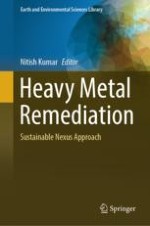2024 | OriginalPaper | Buchkapitel
Biotechnological Strategies for Effective Remediation of Heavy Metals
verfasst von : Muibat Omotola Fashola, Olajide Solomon Anagun, Mautin Lawrence Ogun, Prince Emeka Ndimele, Olubukola Oluranti Babalola
Erschienen in: Heavy Metal Remediation
Verlag: Springer Nature Switzerland
Aktivieren Sie unsere intelligente Suche, um passende Fachinhalte oder Patente zu finden.
Wählen Sie Textabschnitte aus um mit Künstlicher Intelligenz passenden Patente zu finden. powered by
Markieren Sie Textabschnitte, um KI-gestützt weitere passende Inhalte zu finden. powered by
